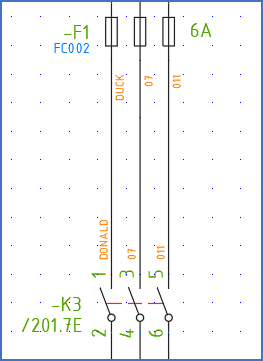|
<< Click to Display Table of Contents >> Presentation of incorrect wire-numbering |
  
|
|
<< Click to Display Table of Contents >> Presentation of incorrect wire-numbering |
  
|
An incorrect wire-numbering means, somewhat simplified, that the ingoing and outgoing wire-numbers do not make sense. Within a sub-node, you might have multiple equal outgoing wire-numbers, multiple equal ingoing wire-numbers, outgoing wire-numbers not corresponding to ingoing wire-numbers, the other way around, or other similar errors. To view that kind of errors as “half wires” can be a good way of visualising them. (A "half wire" then means a wire with only one end, either only a beginning but not an end, or only an end but not a beginning).
When errors like these are presented in the wire-list, they are displayed with a clear and distinct error icon on the far left, as you can see an example of in the figure below.

Figure 2027: A simple point-to-point wire with errors in the wire-numbers
The simple case shown above is a sub-node consisting of one single wire where outgoing and ingoing wire-numbers do not make sense - they do not match. Ingoing is DONALD and outgoing is DUCK. In the wire-number column of the wire-list, both those wire-numbers are presented, but within brackets to clearly visualise, that this is erroneous.
Correcting errors of this kind directly in the wire list, can be done in more than one way. In the following sub-topics, a few possible ways are described.

Figure 2028: The wire between -K3:1 and -F1:2 is incorrectly numbered, as opposed to the two other wires that are shown here.